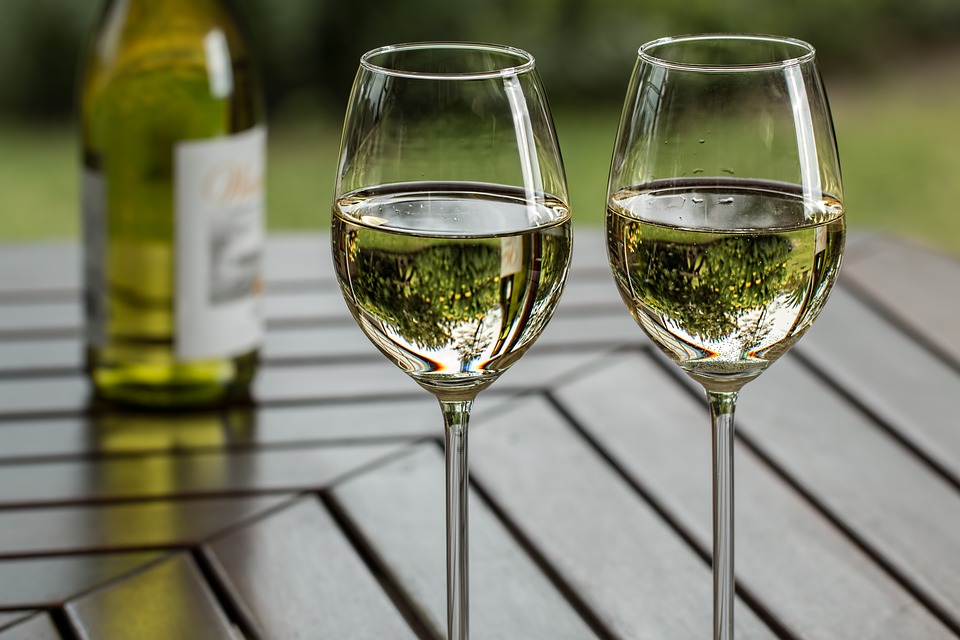It’s summer, and you’re hankering for a glass of something refreshing and delicious. Browsing the aisles at the grocery store you notice two types of white wine dominate the displays– Sauvignon blanc and Chardonnay. You read the labels and between both you notice some common flavors, but you know that can’t be right. A friend absolutely swears by one, but detests the other. Many of the labels list similar notes, but how do you know what you’re getting? It’s really much easier than you might think.
Both Chardonnay and Sauvignon blanc are made from green grape varieties and have a range of flavors and subtleties that can depend on where they’re grown, the temperature of the climate, the ripeness of the grapes, and differences in the winemaking process itself. True, there are some instances between the two types where differences are slight and might only be noticed by the serious wine people, but there are a few primary factors that will help the more casual drinker spot the differences immediately.
General differences
Sauvignon blanc
Sauvignon blanc comes from the Bordeaux region in southern France and tends to range from very light to light-body with strong “green” flavor notes and higher acidity, reminiscent of grass, lime, grapefruit, and can even have a “mineral” flavor on occasion. Sauvignon blanc in general tends to be more acidic and sharp in flavor and pairs best with lighter foods, such as flaky fish, goat cheese, and gazpacho. Depending on where it’s grown and the climate, Sauvignon blanc may edge into a tropical fruit flavor profile with a lower acidity. This usually means that the climate it was grown in was warmer and the grapes used to make it were riper. A Sauvignon blanc grown in a cooler climate tends to carry more towards crisp flavors like apple, citrus, or gooseberry.
The way it is manufactured will also have an effect on the overall flavor and texture of the wine. If a Sauvignon blanc made in a steel or concrete vat (the most common way of producing it) it will offer more “traditional” citrusy green notes as opposed to a barrel fermented Sauvignon blanc (the more expensive kind) which will possess a creamier texture due to the yeast used in the fermentation process. If it is aged in oak it may even have added hints of lemon curd or creme brulee, which is closer to what you’d find in an oaked Chardonnay.
This is where things might start to become hazy, but the trick is to remember that this is more the exception for Sauvignon blanc and not the rule.
Now let’s talk about the most planted grape in the world– Chardonnay.
Chardonnay
Chardonnay is a wine from the Burgundy region in France, and is one of the most versatile because of its range of subtle flavors. As much as a Sauvignon blanc is intense, light-bodied and sharp, a good Chardonnay is full-bodied and delicate in flavor.
Often this has to do with the fermentation process. The full-body of an oaked Chardonnay is due mostly to malolactic fermentation which occurs in oak barrels where malic acid is converted with special bacteria to lactic acid and create the buttery feeling on the tongue usually associated with this type of Chardonnay. Oaked Chardonnays pair best with heavier foods like pastas in cream based sauces, squashes, and mushrooms, while an unoaked Chardonnay like a Chablis that has not gone through malolactic fermentation pairs better with an array of lighter fare, such as sushi or vegetables.
Unoaked Chardonnays in particular might taste similar to a Sauvignon blanc in that the drinker might taste a zing or a minerality, but without the “green” notes that are indicative of a Sauvignon blanc.
Going deeper
That’s the gist, and that’s all you really need to know if you’re just browsing. But if you’re serious about getting acquainted with some of the more intricate details of why these wines taste the way they do, here is a broad strokes overview.
Besides the differences brought about by ageing processes, a colossal amount of what makes up the taste of a wine is its terroir, which is four basic elements reflective of where the wine comes from: soil, climate, terrain, and tradition. Wine aficionados differ in the opinion of what terroir encompasses, whether it’s just the specific vineyard or the wider region the wine comes from, but they agree that the following components bear weight regardless of how localized they might be.
Soil – The nutrients or minerals present in the soil can have a huge effect on taste, as roots from the vines will soak up what is available to them. A rockier soil may cause the wine to have a “gravely” or “mineraly” flavor profile like what you would find in a New Zealand Sauvignon blanc.
Climate – As a rule, the warmer the climate the more sugar is present, which not only produces higher alcohol content but reduces acidity. For example, a Chardonnay grown in California will have a richer flavor due to the higher sugar content than a French Chardonnay which might taste a bit sharper due to a slightly cooler temperature.
Terrain – The vineyards elevation, how far inland it is, and what might be around it (various plants, mountains, water bodies, etc.) have a significant effect on the taste of wine in different regions. Higher elevation, for instance, means cooler temperatures and therefore will affect acidity. Terrain also encompasses soil composition, as discussed above, as a flavor influence.
Tradition – The method of winemaking itself, and is more present in Old World wines than New World. This can be largely dependent on any of the elements listed above.
It’s perfectly acceptable to just enjoy a glass of wine for what it is in that moment, but the next time you have your friends over for dinner, you might be able to help them understand their preferences.

